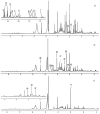Effect of Defatted Dabai Pulp Extract in Urine Metabolomics of Hypercholesterolemic Rats
- PMID: 33202660
- PMCID: PMC7697915
- DOI: 10.3390/nu12113511
Effect of Defatted Dabai Pulp Extract in Urine Metabolomics of Hypercholesterolemic Rats
Abstract
A source of functional food can be utilized from a source that might otherwise be considered waste. This study investigates the hypocholesterolemic effect of defatted dabai pulp (DDP) from supercritical carbon dioxide extraction and the metabolic alterations associated with the therapeutic effects of DDP using 1H NMR urinary metabolomic analysis. Male-specific pathogen-free Sprague-Dawley rats were fed with a high cholesterol diet for 30 days to induce hypercholesterolemia. Later, the rats were administered with a 2% DDP treatment diet for another 30 days. Supplementation with the 2% DDP treatment diet significantly reduced the level of total cholesterol (TC), triglyceride, low-density lipoprotein (LDL), and inflammatory markers (C-reactive protein (CRP), interleukin 6 (IL6) and tumour necrosis factor-α (α-TNF)) and significantly increased the level of antioxidant profile (total antioxidant status (TAS), superoxide dismutase (SOD), glutathione peroxide (GPX), and catalase (CAT)) compared with the positive control group (PG) group (p < 0.05). The presence of high dietary fibre (28.73 ± 1.82 g/100 g) and phenolic compounds (syringic acid, 4-hydroxybenzoic acid and gallic acid) are potential factors contributing to the beneficial effect. Assessment of 1H NMR urinary metabolomics revealed that supplementation of 2% of DDP can partially recover the dysfunction in the metabolism induced by hypercholesterolemia via choline metabolism. 1H-NMR-based metabolomic analysis of urine from hypercholesterolemic rats in this study uncovered the therapeutic effect of DDP to combat hypercholesterolemia.
Keywords: NMR metabolomics; anti-inflammatory; antioxidant; defatted dabai pulp; hypercholesterolemia; supercritical fluid extraction; total dietary fibre.
Conflict of interest statement
The authors declare that they have no known competing for financial interests or personal relationships that could have appeared to influence the work reported in this paper.
Figures




References
-
- Badimon L., Chiva-Blanch G. Lipid Metabolism in Dyslipidemia and Familial Hypercholesterolemia. Elsevier Inc.; Amsterdam, The Netherlands: 2018.
-
- Perk J., De Backer G., Gohlke H., Graham I., Reiner Ž., Verschuren M., Albus C., Benlian P., Boysen G., Cifkova R. European Guidelines on cardiovascular disease prevention in clinical practice (version 2012) Eur. Heart J. 2012;33:1635–1701. - PubMed
-
- Institute for Public Health Malaysia . National Health and Morbidity Survey (NHMS) 2019: Non-Communicable Diseases, Healthcare Demand, and Health Literacy—Key Findings. National Institutes of Health (NIH) Ministry of Health Malaysia; Shah Alam, Malaysia: 2020.
MeSH terms
Substances
Grants and funding
LinkOut - more resources
Full Text Sources
Medical
Research Materials
Miscellaneous

